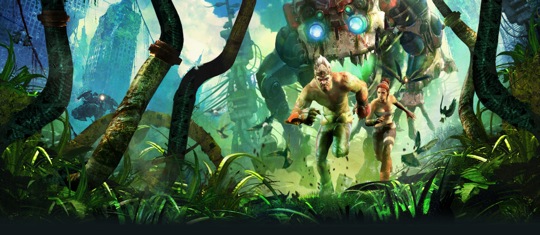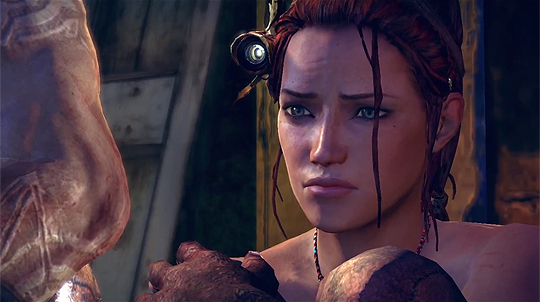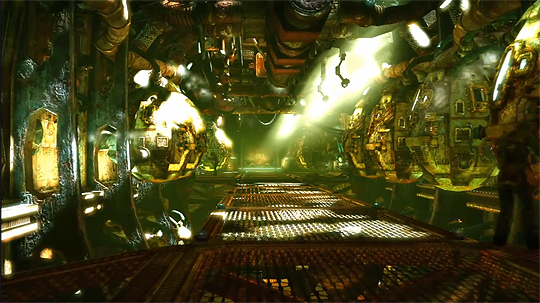
Enslaved: Odyssey to the West is a game that has some shiny problems. They’re not glaring problems, but just shiny enough to catch your eye as you encounter them. Controlling the main character — named Monkey either because he climbs like a monkey or is a big lovable ape — is somewhat unresponsive and clumsy. The combat is simplistic, and can be repetitive. There are also glitches that pop up throughout the game, but rarely any that require a reset. These are things that, when combined, will understandably drive down the review score of an otherwise good game, but in the case of Enslaved: Odyssey to the West, it just doesn’t work like that.
The folks over at Ninja Theory, the development team behind Enslaved, approach their games differently than the average studio, devoting a Pixar level of peparation to an element that most hand off to one or two writers. Story, and to an even greater degree, characters, are everything in Enslaved. The two elements work together to drive the experience forward in every respect, and it pays off. The game is not perfect, and neither is the story, but it is told so well, and the world and the people who live there are so well realized, that you just want to be there and experience what is being offered.
The characters’ performances and animations are particularly exemplary, and put many digital actors to shame. Andy Serkis, who played Gollum in the Lord of the Rings films, takes the lead role of Monkey and delivers an absolutely believable performance as the gruff loner. Trip is played by Lindsey Shaw and delivers an often genuinely heart-wrenching genius, in a sympathetic circumstance. It’s unusual to mention the names of a game’s voice actors in its review, but they deserve the recognition, as they are both a big part of what makes Enslaved so great.

Enslaved takes place in a future where humanity’s chokehold on the world has been dwindling for a few hundred years. AI-controlled mechs roam the landscape searching for humans to enslave, and those who resist are killed. You play as Monkey, an unfortunate capture who gets incidentally freed by Trip. Trip places a slave headband on Monkey that is fatally connected to her. If she dies, you die, so you are forced to cooperate with her and be her slave, and BAM! The title of the game suddenly makes perfect sense. Luckily, Trip is actually a really nice person, and even though you may have a bit of rough exterior as Monkey, you’re a pretty good guy, too. What follows is a series if mishaps, mech fighting, and friendship blossomings as you protect Trip on her way home. There is actually a whole lot more to the story than that, but to go into any more detail would hurt the core experience of the game. Just know that you are going to want to know what is happening next, and you will push forward to the end to find out.
The actual gameplay is of the fighting, jumping, puzzling kind. The combat is fairly simple and is mostly melee crossed with a bit of shooting. Melee breaks down to heavy and light attacks, with a couple of simple special moves distributed for good measure. The combat rarely provides too extreme of a challenge, but is a joy to watch. Using the phrase, "a joy to watch," actually goes a long way to describe many elements of the game. The platforming and puzzle elements serve mainly to show off the game’s excellent art direction and animation. Much like 2008’s Prince of Persia, platforming ends up being an almost passive experience. You have control of Monkey as he leaps and climbs all cover the world, but it is literally impossible to make a mistake. If you know where to go, push the control stick in that direction and repeatedly press A. If you’re not sure where to go, and you push the control stick in the wrong direction, Monkey will stay put. It’s as if he knows exactly where to go, and your only purpose as the player, is to tell him when he is allowed to move forward. It leads to very little challenge throughout the game, but it is still fun to watch Monkey swing and leap his way throughout the world. (Editor’s note: This platforming is as fine an example of interactive spectatorship as gamers will see in today’s gaming landscape.)

As Monkey, you may be protecting Trip, but you are not her babysitter. Actual confrontations between Trip and the mechs are rare. Most of the time, she is perfectly capable of taking care of herself in some safe corner as you beat the angry robots to mechanical death. This makes Trip much less of a liability than the average gaming sidekick. In fact, the few areas where she is not around to provide helpful backup end up being the parts of the game that can be frustrating. You work better as a team, and it helps to create a stronger emotional bond between the two characters.
The developers at Ninja Theory have openly stated that they create their games in the interest of pushing forward storytelling in games. With very few exceptions, videogame stories and characters are often only as compelling as the armor they equip. Enslaved won’t be the game that will tip the industry scale toward the serious artistic medium we all want it to be, but it has certainly added a lot of weight.


















